 11 Aug 09
11 Aug 09 20 Sep 09
20 Sep 09 6 Nov 09
6 Nov 09[ Home ] [ Up ] [ Previous Page ] [ Next Page ]
Dallee Electronics has been making model railroad sound systems for a long time. Their stuff doesn't produce the highest quality sound but the quality is easily good enough. Their prices aren't the highest either, typically $99 MSRP, less on the street. AristoCraft is now selling Dallee systems for use in AristoCraft locomotives since PH Hobbies went out of business.
Dallee's systems are configured to work with just about any power configuration out there, straight track power (with battery backup), DCC, and a variety of battery/RC systems. There are also AC versions for the 3-rail crowd.
Dallee boards come preconfigured for "manual" or "automatic" operation. The manual version is intended for DCC or RC systems that have user operated triggers for the bell and whistle/horn. These systems can be "played" from the throttle to some extent. The automatic systems are intended to be triggered from track magnets so that the trigger signal will play a pre-programmed bell or whistle/horn sequence. The versions are offered for most or all sound files, but one version may not be convertable to the other. Order it the right way.
The sound files cannot be easily changed either. They come the way that they are. Older Dallee systems could have their sound program changed with a microprossor swap. Since the newer ones have a socketed processor as well, this may still be possible. This means that a dealer has to stock many different versions instead of a "generic" board that can be programmed with new sound files such as the Phoenix, QSI, Soundtraxx, LokSound and Digitrax sound systems.
I've used, and still use, 3 varieties of Dallee sound system, one older diesel system, one older steam system and three recent diesel systems. The systems are adequate and typically install without much hassle.
Dallee systems are powered a little differently that most of the others. The connections that go to the motor to allow a Dallee board to sense speed but WILL NOT power the board. There are other terminals for that. Therefore, you need to provide BOTH the motor leads AND some power leads to the system. The motor leads also do not provide any directional information. The Dallee board doesn't deal with running direction.
Newer Dallee boards have individual connectors on the board for the various connections that it needs. Most of them are two terminal connectors. Dallee provides a pigtail connector with red/gray wires that connect to these. There are also two three terminal connectors, a pigtail of red/black/white wires is provided for one of these. The other is not used by the diesel systems. I would guess that it is the chuff trigger for steam systems.
Older Dallee boards (the ones with the larger microprocessor package) use different connectors for pretty much the same functions. These haven't been made in years so users are not likely to run into one that hasn't been installed already.
| Connector | Pin | Function | Notes |
|---|---|---|---|
| J1 | 1 | Track Power |
Polarity Insensitive 24 VDC or DCC max, 18 VAC max |
| 2 | |||
| J2 | 1 | Positive DC Input |
IMPORTANT, POLARITY SENSITIVE 24 VDC max Can also be used with a 9V backup battery, traction battery or storage capacitor |
| 2 | Negative DC Input | ||
| J3 | 1 | Track Input | Only used when the Dallee sound controller is added to a DC power system |
| 2 | Motor | Connects to one side of the motor | |
| 3 | Motor | Connects to the other side of the motor | |
| J4 | 1 | Horn Function | Connect to F2 of a DCC decoder |
| 2 | Bell Function | Connect to F1 of a DCC decoder | |
| J5 | 1 | Force Notch 8 | Optionally connect to any available function of a DCC decoder |
| 2 | Mute | Optionally connect to F8 (usually) of a DCC decoder | |
| Speaker | 1 | 8Ω speaker | 8Ω or higher, system will not drive a 4Ω speaker |
| 2 | |||
| Sync | 1 | No connect | Not used for diesel systems. This is probably the chuff trigger for steam systems. |
| 2 | |||
| 3 |
The Dallee systems are not completely polyphonic. Some models, especially the older ones, don't play more than one sound at a time. If you blow the whistle, the chuff or engine sound may stop. Newer systems fake an engine sound behind the bell.
The audio output power of the Dallee systems are set with an on board volume control. There is plenty of audio power available, enough such that it is not reasonable to run it flat out.
Diesel systems have a manual adjustment to allow the engine sound to be matched to the locomotive. This should be tweaked to get the best combination of the transition of the engine sound as it leaves idle and the speed where the maximum rate engine sound occurs. I've found that the easiest way to adjust the "speed" is to tweak it until the system just plays an air release at the lowest throttle setting that causes the engine to just start to move.
Steam systems can have their chuff triggered by external sensor or via voltage control. For voltage control, the speed adjustment sets the chuff rate as a function of motor voltage.
The boards are not the physically smallest ones available, but they are not the largest either. Their form factor tends to be long and skinny so that they will actually fit within some HO shells such as an empty "B" unit. Including the attached foam mounting tape and connector bodies, the Dallee board is about 2.7" long by 0.95" wide by 0.6" high.
Older Dallee systems did not play sound sequences so that they did not work with track magnet triggered sounds. However, the newer versions can be ordered in an "automatic" configuration that allows magnetic triggers. I don't have one of those so I don't know how well it actually works.
Dallee provides a "mute" command. If the mute wire is grounded via a physical switch or a DCC decoder function, the sound will go off. Dallee systems to not "time out" due to inactivity. Sometimes it is best if there is no sound, at least there is an easy way to shut it off.
The current consumption is pretty low on the newer Dallee boards. With the volume turned all the way up and running from about 18 volts, the board draws very little current so that it is well suited to battery power installations.
| Mode | Current (ma) |
|---|---|
| Mute | 10 |
| Engine Idle | 33 |
| Engine Run 8 | 33 |
| Bell | 40 |
| Horn | 130 |
 11 Aug 09
11 Aug 09 20 Sep 09
20 Sep 09 6 Nov 09
6 Nov 09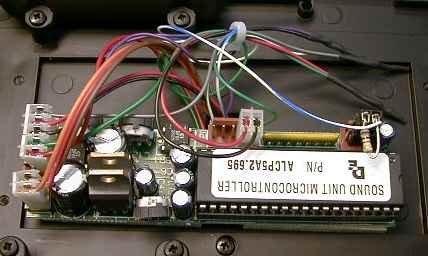 The first sound
system I installed after I started conversion to DCC in about 1998 was
a Dallee Alco Diesel that went into my 2nd AristoCraft RS-3. I normally run this RS-3
consisted with an even older RS-3 (neither have the newer motor blocks)
which has a PH Hobbies sound system in it. I usually run only one of
the sound systems at a time. Both are adequate to the point that I see
no point in spending more money by "upgrading" to a better system. The
Dallee system has given me very little hassle, it has not been touched
in about 10 years.
The first sound
system I installed after I started conversion to DCC in about 1998 was
a Dallee Alco Diesel that went into my 2nd AristoCraft RS-3. I normally run this RS-3
consisted with an even older RS-3 (neither have the newer motor blocks)
which has a PH Hobbies sound system in it. I usually run only one of
the sound systems at a time. Both are adequate to the point that I see
no point in spending more money by "upgrading" to a better system. The
Dallee system has given me very little hassle, it has not been touched
in about 10 years.
I recently recorded this video of the RS-3 with the Dallee system. Basically, all of the sounds that it makes are in this video.
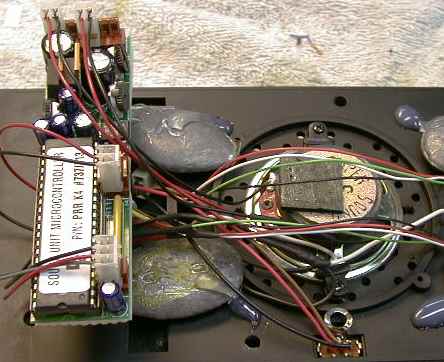 The stock
analog sound system that came in the AristoCraft Slopeback Tender was
so bad that I had to change it out. I elected to try a Dallee generic
steam system when I converted the AristoCraft 0-4-0 to DCC. The Dallee board
fit nicely where the old PWB had been and is accessible through the
coal load hatch. This is the older version which does not provide the
best quality sound available, but it is good enough. I don't know what
the newer steam systems sound like. I shot a short video demonstrating the sound
made by this older Dallee board.
The stock
analog sound system that came in the AristoCraft Slopeback Tender was
so bad that I had to change it out. I elected to try a Dallee generic
steam system when I converted the AristoCraft 0-4-0 to DCC. The Dallee board
fit nicely where the old PWB had been and is accessible through the
coal load hatch. This is the older version which does not provide the
best quality sound available, but it is good enough. I don't know what
the newer steam systems sound like. I shot a short video demonstrating the sound
made by this older Dallee board.
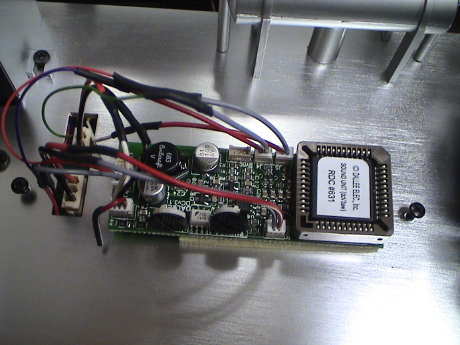 Dallee has redesigned their
sound systems sometime in the last decade. This is a "non-automatic"
version for the RDC intended to be used with DCC or battery/RC. It is
stuck to the bottom of the RDC with the supplied foam mounting tape.
This is not a plug and play installation as Dallee didn't provide the
connectors to integrate with the connectors on the RDC. I happened to
have a set of connectors for the motor input and speaker output, but I
still had to provide power to the track input. I had to crack open the
RDC to bring track power to the
Dallee board. I also brought four function wires from the DG383AR DCC
decoder back to the Dallee to control the horn, bell, mute and force
run up functions on the Dallee board. However it all worked as
planned.
Dallee has redesigned their
sound systems sometime in the last decade. This is a "non-automatic"
version for the RDC intended to be used with DCC or battery/RC. It is
stuck to the bottom of the RDC with the supplied foam mounting tape.
This is not a plug and play installation as Dallee didn't provide the
connectors to integrate with the connectors on the RDC. I happened to
have a set of connectors for the motor input and speaker output, but I
still had to provide power to the track input. I had to crack open the
RDC to bring track power to the
Dallee board. I also brought four function wires from the DG383AR DCC
decoder back to the Dallee to control the horn, bell, mute and force
run up functions on the Dallee board. However it all worked as
planned.
The sound is a little cleaner than the earlier Dallee boards as can be heard in this video taken while the RDC was on test rollers getting it's initial sound shakedown.
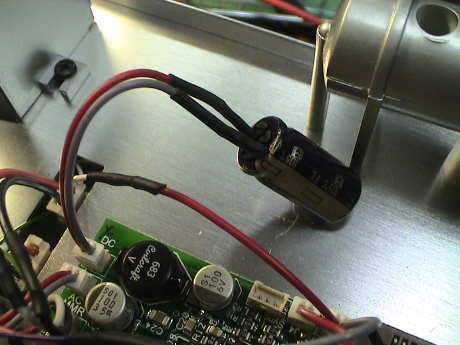 The Dallee system did have
a little sensitivity to dirty track, sometimes it would restart on
particularly bad sections while the RDC kept going. Dallee provides a
DC connector on the board intended to be used as polarized power input
for systems were a fixed polarity DC voltage is available. This is also
where a storage capacitor can be added to allow the Dallee system to
hold up better in the case of short power interruptions. Dallee
recommends a 470µF or larger capacitor be used. I used a
680µF 25 volt capacitor because that is what I had handy. It
worked fine. The system now runs through outages of around 0.3 seconds,
enough to prevent the resets unless the RDC actually stalls. The
capacitor is simply soldered to one of the Dallee supplied red/gray
connectors (observe polarity) and plugged in.
The Dallee system did have
a little sensitivity to dirty track, sometimes it would restart on
particularly bad sections while the RDC kept going. Dallee provides a
DC connector on the board intended to be used as polarized power input
for systems were a fixed polarity DC voltage is available. This is also
where a storage capacitor can be added to allow the Dallee system to
hold up better in the case of short power interruptions. Dallee
recommends a 470µF or larger capacitor be used. I used a
680µF 25 volt capacitor because that is what I had handy. It
worked fine. The system now runs through outages of around 0.3 seconds,
enough to prevent the resets unless the RDC actually stalls. The
capacitor is simply soldered to one of the Dallee supplied red/gray
connectors (observe polarity) and plugged in.
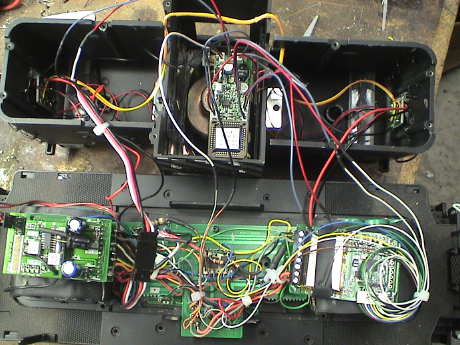 Based
on the results of the RDC installation, I went for Dallee one more
time, this time in an Aristo Center
Cab switcher. This was a complicated installation because this loco
already had a full up battery RC system AND a DCC decoder installed so
that I could run it in dual mode. There wasn't room in the hoods for
the Dallee board and the speaker was a problem so I installed the works
inside the cab after removing the cab interior.
Based
on the results of the RDC installation, I went for Dallee one more
time, this time in an Aristo Center
Cab switcher. This was a complicated installation because this loco
already had a full up battery RC system AND a DCC decoder installed so
that I could run it in dual mode. There wasn't room in the hoods for
the Dallee board and the speaker was a problem so I installed the works
inside the cab after removing the cab interior.
However it all worked as expected and the Dallee board sounds MUCH better than the older diesel board that is in an RS3. Dallee has made some serious improvements over the years.
This link goes to a movie demonstrating the sound made by the Dallee #731 sound system.
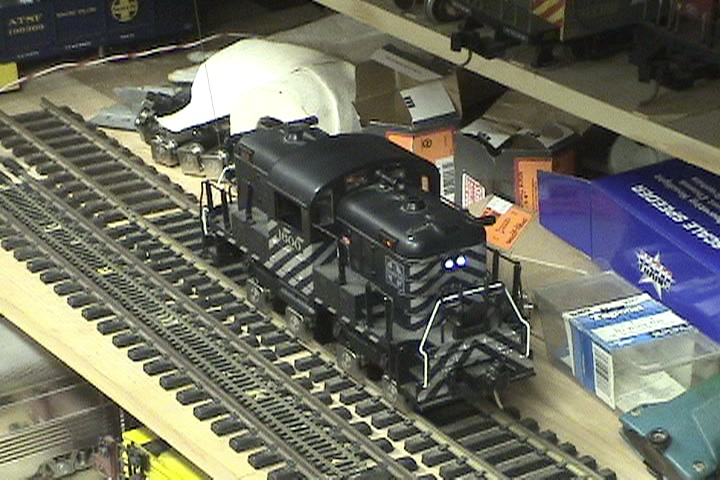
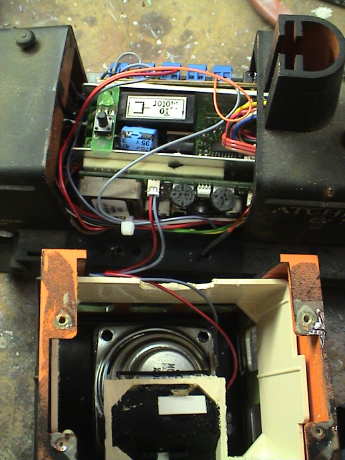 The
last loco in my roster without sound (besides a couple of B units that
will never get sound) was a battery/RC powered LGB 2060 industrial diesel. I
selected a Dallee #632 (Railbus) for this installation because it
sounded like a small diesel. It actually sounds more like an RDC that
the RDC system does. This system plays an engine sound that varies in
tempo with speed but has no transitions or shifts. The horn and bell
are good.
The
last loco in my roster without sound (besides a couple of B units that
will never get sound) was a battery/RC powered LGB 2060 industrial diesel. I
selected a Dallee #632 (Railbus) for this installation because it
sounded like a small diesel. It actually sounds more like an RDC that
the RDC system does. This system plays an engine sound that varies in
tempo with speed but has no transitions or shifts. The horn and bell
are good.
In this system, the bell and horn are manually triggered from an external ART-5495 relay board that plugs into the 4590 receiver.
When the system was first installed and the video below was made, the loco was battery/RC only. Since then, I've added a DCC decoder to the loco. The functions are set up so that the sounds (all 4 functions) can be controlled from either the DCC decoder or the Train Engineer.
I have an Aristo FA that had been converted to battery power with an Aristo 5490 onboard TE receiver. Later it got an MRC AD322 DCC decoder but the MRC sounded so poor, and it didn't run on battery, that I took it out and installed a DG583S and a Dallee #696 sound system instead. I did this along the lines of the installation in the LGB 2060 so that I could use an Aristo 5495 accessory board to control the sound as well when running on battery power. The installation is described in more detail in my FA Tips page.
The Dallee #696 doesn't have the best quality sound in the Dallee lineup, but it is a lot better than the MRC AD322. The movie below demonstrates the sound of this board.

[ Home ] [ Up ] [ Previous Page ] [ Next Page ]
This page has been accessed times since 19 Dec 08.
© 2008-2009 George Schreyer
Created 19 Dec 08
Last Updated November 6, 2009